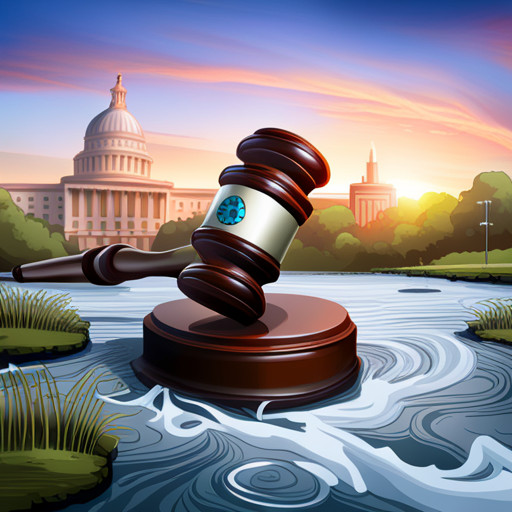Health Risks Meet Legal Risks: Navigating the Murky Waters of Environmental Litigation
Recent studies indicate that approximately 16% of global deaths are attributed to environmental damage. This article delves into the complex intersection of environmental degradation, health risks, and legal challenges.

It explores potential health impacts and legal intricacies of environmental cases, provides strategies for navigating environmental lawsuits, and underscores the crucial role of law in environmental health protection.
The discussion is further substantiated with relevant case studies.
Key Takeaways
- Environmental litigation plays a crucial role in enforcing and shaping environmental regulations.
- Health and environmental considerations should be incorporated into legislation to strike a balance between safeguarding public health and protecting the environment.
- Environmental pollution is linked to a wide range of health conditions, and legal frameworks are needed to address the health consequences of environmental degradation.
- Proving environmental damage in litigation cases requires thorough investigations, scientific analysis, and a multidisciplinary approach.
Understanding Environmental Litigation

Environmental litigation, a critical aspect of environmental law, involves legal disputes related to the protection of the environment or the impacts of human activity on it. These litigations often arise when environmental regulations are perceived to have been violated or disregarded, leading to potential harm to the environment, wildlife, or human health.
In the complex, multi-faceted realm of environmental law, litigation serves as an important tool for enforcement. It provides a platform for the resolution of disputes, which can include issues such as pollution, waste disposal, resource extraction, and climate change. The interpretation and application of environmental regulations form the crux of these disputes.
One of the primary objectives of environmental litigation is to ensure compliance with these regulations. This is achieved by holding entities accountable for their actions that contravene these rules, such as illegal dumping of hazardous waste or failure to adhere to emissions standards. The litigation outcomes, therefore, often involve penalties for the offending party, which can include fines, injunctions, and in severe cases, criminal charges.
By scrutinizing the litigation outcomes, it can be discerned that environmental litigation plays a pivotal role not only in enforcing environmental regulations but also in shaping them. The outcomes of these legal disputes often highlight the gaps and ambiguities in existing regulations, leading to their refinement and improvement.
Thus, environmental litigation serves as a critical mechanism in the ongoing evolution and enforcement of environmental regulations, thereby playing a vital role in the protection of the environment and human health.
The Intersection of Health and Legal Risks

The intersection of medical and juridical challenges presents a complex landscape in the realm of ecological disputes. As societal understanding of the pervasive impact of environmental factors on public health deepens, the nexus between Healthcare Legislation and Environmental Policies becomes increasingly intricate.
A detailed examination of these complexities reveals a multi-layered system of legalities and medical realities. Environmental policies, designed to safeguard natural resources, often have significant implications for public health. Air and water pollution, for instance, can lead to severe health problems, highlighting the need for stringent environmental regulations. However, implementing these policies without infringing on the rights of various stakeholders can prove challenging.
On the other hand, Healthcare Legislation, aimed at protecting public health, can inadvertently have environmental impacts. The disposal of medical waste, for instance, if not properly managed, can pose severe environmental risks. Therefore, policy-makers must strike a delicate balance between safeguarding public health and protecting the environment.
In the dynamic interplay between Healthcare Legislation and Environmental Policies, it becomes clear that these two domains are not isolated but interconnected. A persuasive argument can be made for a holistic approach that incorporates both health and environmental considerations in legislation.
Potential Health Impacts of Environmental Damage

Potential impacts of ecological degradation on human wellbeing extend beyond the immediately observable, often manifesting in chronic diseases and other long-term medical conditions. A plethora of studies underscores the linkage between environmental pollution and a broad spectrum of health conditions, emphasizing the pressing need for legal frameworks to address these intertwined issues adeptly.
Pollution induced diseases, including respiratory ailments, cardiovascular diseases, and cancers, are increasingly prevalent. The World Health Organization reports that pollution accounts for an estimated 25% of all deaths and diseases globally. Furthermore, the prevalence of diseases associated with airborne particulate matter, such as asthma and lung cancer, has risen dramatically in regions with high levels of air pollution.
Climate change repercussions present another layer of complexity. With rising temperatures and unpredictable weather patterns, vector-borne diseases such as malaria and dengue are expected to surge, posing significant health threats. Moreover, heatwaves have been linked to increased mortality rates, particularly among vulnerable populations such as the elderly and those with pre-existing health conditions.
In recognition of these mounting challenges, legal systems worldwide are increasingly being called upon to address environmental degradation and its health consequences. From a legal perspective, linking specific health impacts to environmental damage can be challenging due to the multitude of contributing factors. However, it is essential to tackle this complexity head-on in order to establish effective and just legal responses to these pressing public health threats.
Legal Challenges in Environmental Cases

In the legal arena of environmental cases, two significant challenges often arise: proving environmental damage and navigating the inherent legal complexities.
Establishing tangible evidence of environmental harm can be an arduous process, necessitating thorough investigations and sophisticated scientific analysis to build a compelling case.
Additionally, the convoluted legal landscape, typified by intricate regulations and multifaceted jurisdictional issues, further complicates such cases, demanding astute understanding and adept maneuvering of the legal system to secure justice.
Proving Environmental Damage
Establishing clear evidence of environmental harm often presents a significant hurdle for plaintiffs in environmental litigation cases. This challenge is further compounded by the intricacies of damage quantification, which necessitates a delicate balance of scientific understanding and legal expertise.
In this context, environmental whistleblowers play a pivotal role by providing insider knowledge and shedding light on otherwise concealed environmental atrocities. Their testimonies can contribute greatly to the evidence pool, aiding in the robust quantification of environmental damage. However, the credibility of such information is contingent on rigorous validation and corroboration.
Thus, a multidisciplinary approach, integrating legal, scientific, and investigative competencies, is critical in successfully proving environmental harm in litigation cases. This approach ensures the accuracy and defensibility of the presented evidence, thereby bolstering the plaintiff's case.
Navigating Legal Complexities
Understanding and maneuvering through the labyrinthine intricacies of law can pose a significant challenge in cases related to environmental damage. Legal loopholes often permit offenders to evade accountability, further exacerbating the difficulty of securing justice. Expertise in identifying these loopholes and understanding their implications is pivotal in such instances.
Regulatory compliance, on the other hand, holds substantial sway in determining the outcome of litigation. In-depth familiarity with environmental laws and regulations is therefore crucial. It enables the navigation of legal complexities and the anticipation of potential challenges.
Consequently, a detailed, analytical approach to these complexities, coupled with a persuasive argument, can lead to positive outcomes in environmental litigation, thus ensuring the protection of the environment and the health of the populace.
Strategies for Navigating Environmental Lawsuits

Strategies for navigating environmental lawsuits require a comprehensive understanding of both environmental and legal principles. This understanding is crucial for two primary aspects: lawsuit prevention and damage assessment.
Lawsuit prevention refers to the proactive measures that can be taken to avoid litigation in the first place. This necessitates a thorough comprehension of environmental regulations and standards, as well as the ability to ensure compliance with these rules. Furthermore, organizations should also develop risk management plans that can help anticipate and mitigate potential environmental risks.
Damage assessment, on the other hand, comes into play when environmental litigation is unavoidable. This involves the evaluation of the environmental harm caused by a certain action or event, as well as the quantification of any related costs. It is a complex process, requiring specialized knowledge in areas such as toxicology, ecology, and economics, among others. Accurate damage assessment is critical as it can significantly influence the outcome of the lawsuit and the extent of liability for the parties involved.
The Role of Law in Environmental Health Protection

In the context of protecting the quality of the environment, the law plays a crucial role, enforcing regulations and standards that aim to prevent, mitigate, and redress harm to the ecosystem. Legislation and regulatory frameworks provide a structure within which environmental health can be monitored, maintained and improved.
The policy impact on environmental health is significant. Policies set the agenda for how environmental issues are addressed, and laws provide the tools for implementation. For instance, the Clean Air Act in the United States has had a profound effect on reducing air pollution and associated health risks. Similarly, the European Union's stringent laws on chemical substances have led to improved environmental health outcomes.
Legal precedents also play a critical role in environmental health protection. These precedents set benchmarks for future legal decisions and can shape the interpretation and application of environmental laws. For example, the historic ruling in the case of Massachusetts v. Environmental Protection Agency established the authority of the EPA to regulate greenhouse gases under the Clean Air Act, a decision that has had far-reaching implications for environmental health.
However, it is vital to ensure that laws and policies are not only enacted but are also enforced effectively. Regulatory compliance and enforcement are key to achieving desired environmental health outcomes. Additionally, laws and policies must be updated regularly to reflect evolving scientific understanding and emerging environmental health challenges.
Case Studies: Environmental Litigation Impact on Health

Understanding the impact of environmental litigation on health necessitates a comprehensive examination of notable cases where environmental hazards were directly linked to severe health implications.
This discussion will scrutinize the Flint Water Crisis, a tragic event of lead-contaminated water supply that led to extensive public health hazards.
It will also shed light on various asbestos exposure cases, where individuals suffered from debilitating illnesses due to their direct contact with the harmful mineral.
Further exploration will be conducted on pesticide-related health lawsuits, where agricultural chemicals have allegedly caused serious, often fatal, health conditions.
These cases illustrate the importance and urgency of legal redress in environmental health protection.
Flint Water Crisis
The Flint Water Crisis exemplifies the complex interplay between environmental health issues and legal ramifications. An inadequate approach to crisis management led to significant community impact, including widespread lead poisoning and disease outbreaks. Understanding the context and implications of this crisis is critical for future environmental litigation.
| Year | Event | Impact on Community |
|---|---|---|
| 2014 | Water source switched | Lead exposure begins |
| 2015 | First lead warnings | Public fear escalates |
| 2016 | State of emergency declared | Heightened health concerns |
| 2017 | Criminal charges filed | Legal ramifications begin |
| 2019 | Settlement proposed | Some relief, lingering distrust |
This table illustrates the timeline of the Flint Water Crisis, showing how poor crisis management can lead to prolonged community suffering. It also highlights the path from environmental health issue to legal action, a journey fraught with complexity and challenge.
Asbestos Exposure Cases
Moving from the complexities of the Flint water crisis, attention is now drawn to the legal ramifications of asbestos exposure cases. In these situations, the correlation between asbestos exposure and mesothelioma diagnosis is of paramount importance.
The latency period of this deadly disease can span decades, complicating litigation procedures. Asbestos regulation has evolved over time, and so too has the legal landscape. Claims are often made against companies that negligently exposed workers or consumers to asbestos, with proof of exposure and subsequent illness being the crux of such lawsuits.
Therefore, it is imperative to scrutinize the effectiveness of asbestos regulation in preventing exposure and consequent health risks. The exploration of these claims showcases the intricate relationship between environmental health risks and legal risks.
Pesticide-Related Health Lawsuits
Shifting focus to pesticide-related lawsuits, it becomes evident that these cases often revolve around the alleged negligence of manufacturers and the potential harm caused by their products.
Pesticide Regulation Policies are central to these legal battles, acting as a guideline for acceptable practices. These policies, however, often come under scrutiny for potential shortcomings, thus highlighting the importance of diligent revision and enforcement.
A detailed Litigation Outcomes Analysis reveals a growing trend towards holding manufacturers accountable for health damages, with courts increasingly recognizing the link between pesticide exposure and serious health conditions.
It is thus advocated for stricter regulation policies and more rigorous testing of products before market release. This shift in litigation trends sends a clear message to manufacturers about their obligations towards public health.
Frequently Asked Questions
What Are the Career Prospects for a Lawyer Specializing in Environmental Litigation?
Career prospects for environmental litigation lawyers are multifaceted, encompassing areas such as green advocacy training and climate change legislation. These practitioners are primed for growth in emerging fields, buoyed by a heightened public consciousness of environmental issues.
Skill development in these specific law areas will allow professionals to be at the forefront of environmental policy change, offering robust career opportunities in both public and private sectors.
How Can Individuals Contribute to the Prevention of Environmental Damage and Related Health Risks?
What role can individuals play in mitigating environmental damage and its subsequent health risks?
The answer lies in the adoption of personal sustainability practices. By embracing green innovations such as renewable energy sources, recycling, and organic farming, individuals can significantly reduce their carbon footprint.
Additionally, through the conscious use of natural resources, every individual can contribute to the fight against environmental degradation, thereby minimizing related health risks.
Are There Any Specific International Laws or Treaties That Address Environmental Health Protection?
Numerous international laws and treaties address environmental health protection. These include the Basel Convention, the Stockholm Convention, and the Minamata Convention.
Global Environmental Regulations have been established to control pollution, reduce public health impact, and safeguard environmental integrity.
These international agreements demonstrate a global commitment to mitigating the adverse effects of environmental degradation on public health and underscore the need for international cooperation in environmental health protection.
How Does Environmental Litigation Differ From Other Types of Legal Cases?
Environmental litigation differs from other legal cases primarily through its complex integration of scientific data and international law. Comparative analysis shows that litigation strategies often rely on extensive research to demonstrate environmental damage and its health impacts.
This fusion of legal and scientific disciplines can make these cases uniquely challenging yet vital in pursuit of environmental justice and public health protection. Thus, environmental litigation presents a distinct landscape in the broader legal sphere.
Can You Provide a Brief History of Major Environmental Litigation Cases in the Past Decade?
In the past decade, significant environmental litigation cases have emerged. These cases, integral to 'Litigation Impact Analysis', have shaped 'Policy Development Insights'.
For instance, the 2010 BP Deepwater Horizon oil spill resulted in substantial legal consequences, while the ongoing global lawsuits against major fossil fuel companies for climate change impacts underscore the increasing trend towards environmental accountability.
These cases illustrate the evolving landscape of environmental litigation.
Conclusion
In conclusion, the nexus of environmental and legal aspects presents a complex landscape. The potential health risks associated with environmental damage are substantial, necessitating robust legal responses.
However, the inherent challenges in environmental lawsuits call for strategic navigation. Law plays a pivotal role in offering protection against environmental health hazards.
An in-depth analysis of various case studies further underscores the profound impact of environmental litigation on health. It is thus crucial to continue exploring this intersection to ensure optimal health and legal outcomes.

This post has been generated by AI and was not reviewed by editors. This is Not legal advice. Please consult with an attorney.




